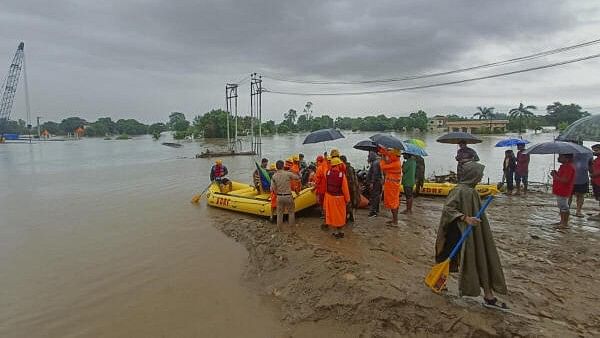
SDRF personnel rescue people from a flood affected area following heavy monsoon rainfall, in Champawat district.
Credit: PTI Photo
Mumbai: Uttarakhand has been witnessing extreme weather events for the past two months, ranging from record breaking temperatures to extremely heavy rainfall triggering flash floods and landslides, as per a report by Climate Trends.
These extreme weather conditions over the last two months have been mainly attributed to climate change, according to a press statement.
Located at the foothills of the Himalayan mountain ranges, Uttarakhand is largely a hilly state having international boundaries with China (Tibet) in the north and Nepal in the east. On its north-west lies Himachal Pradesh, while on the south is Uttar Pradesh.
It is rich in natural resources especially water and forests with many glaciers, rivers, dense forests and snow-clad mountain peaks. Char-dhams, the four most sacred and revered Hindu temples of Badrinath, Kedarnath, Gangotri and Yamunotri are nestled in the mighty mountains.
The year 2024 has come as a surprise for meteorologists and scientists in the case of Uttarakhand.
So far in the monsoon season from June 1 to July 10, the cumulative rainfall for Uttarakhand is 328.6 mm as against the normal of 295.4 mm, resulting in an 11 per cent surplus.
Meanwhile, the summer was a punishing one with severe heat waves gripping almost all districts of Uttarakhand. In June, mercury in Dehradun crossed the 40°C mark for 11 consecutive days from June 9-20. Meanwhile, in May, temperature in the city soared above
On at least five occasions in May, the hill station of Mukteshwar recorded temperatures of nearly 30 degree Celsius, the threshold of a heatwave in the hilly terrain.
Pantnagar also broke its 10-year record, with a day maximum of 41.8°C on June 19. It has recorded 10 consecutive days of above 40°C temperatures from June 11-20.
There has been an increase in the moisture in the atmosphere due to the rise in global average temperature. This leads to the formation of intense clouds, triggering heavy rains. With temperatures rising constantly, these spells of intense rain would be more common,” said Mahesh Palawat, Vice President, Meteorology and Climate Change, Skymet Weather.
"There is a direct relation between extreme heat and forest fires. While we do not deny the fact that forest fires are often man-made, what we saw this year gave us a clear picture of how rising temperatures will exacerbate the situation. Extended dry period paved the way for rise in temperature as well as accumulation of dry leaves. All these factors led to faster dissemination of fire, covering larger areas and resulting in tree cover loss. Putting measures in places well in time can help in saving the forest fires but definitely we need to curb greenhouse gas emissions," said Rajnish Ranjan, a disaster management expert.
In Uttarakhand, the warming temperature trend is worsening forest fire events to a greater extent. Human-caused climate change is influencing weather and climatic extremes in higher elevation places, and many recent studies have reported on the increasingly prevalent elevation-dependent warming (EDW).
EDW influences the Himalayan rivers and glaciers (changes in the glacial mass balance, river discharge, snowfall), which is the only water source for the hilly region’s livelihood.